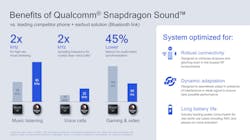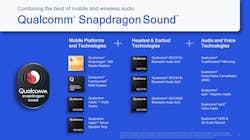Qualcomm Fine-Tunes Wireless Audio Technology to Take on Apple
Qualcomm rolled out a highly integrated package of hardware and software to deliver high-resolution, ultra-low latency audio to smartphones and accessories like wireless headphones and speakers.
The smartphone chip giant said the package, Snapdragon Sound, brings together its existing line of audio technologies, ranging from its advanced audio codecs and software to its Snapdragon SoCs and Bluetooth audio chips for headphones. By more tightly integrating all these parts, Qualcomm is aiming to rival the ease-of-use and high-end audio features in Apple’s AirPods true wireless earbuds.
The announcement builds on Qualcomm's efforts to grab a bigger portion of the growing market for wireless audio devices such as smart speakers and wireless earbuds, a category where Apple's AirPods command close to 50% of the market share. Apple's AirPods have become one of the most popular products in its consumer device business since the first generation was introduced in 2016.
Apple uses its custom-designed H1 Bluetooth audio chip in its latest line of wireless headphones, from its standard AirPods to high-end Pro and over-the-ear Max models. The H1 chip is designed to enable a wide range of special features in Apple's wireless headphones, including the ability for the phone to share audio with more than one pair of AirPods and automatic pairing with an iPhone.
On the other side of the technology stack are Apple's high-performance, A-series iPhone processors. Because its H-series and A-series processors are both designed internally, Apple can plan how they work together to increase robustness, reduce connection times for phone calls, and cut down on latency for consumers watching videos or playing games on their iPhone using AirPods for audio.
By integrating every stage in its stack of wireless audio technologies, Qualcomm hopes to support the same level of audio performance to smartphones that use Google's Android, where it commands a leading share of the central processor and baseband modem market, and accessories like wireless headphones, earbuds, or smart speakers sold by consumer audio brands such as Audio-Technica.
"Our system-level approach aggregates multiple technologies and the latest products from over our mobile and audio platform portfolios to achieve our vision of delivering high-resolution, wired quality audio, wirelessly," said James Chapman, VP and GM of voice, music and wearables at Qualcomm. "By focusing end-to-end, we are looking to deliver innovations to solve common consumer pain-points."
Qualcomm is not rolling out any new products as part of Snapdragon Sound. But it is integrating the components more closely so that they work more effectively together than they do apart.
The key components of Snapdragon Sound include:
- Qualcomm Snapdragon 8-series mobile platform SoCs
- Qualcomm’s FastConnect 6900 WiFi 6 and Bluetooth 5.2 mobile platform
- Qualcomm’s QCC514x, QCC515x and QCC305x series Bluetooth audio SoCs
- Qualcomm’s active noise cancelling (ANC) technology
- Qualcomm’s aptX voice super wideband voice codec
- Qualcomm’s aptX Adaptive, 24-bit 96kHz audio codec
- Qualcomm’s Aqstic audio codec plus WCD938x and WSA883x smart speaker amplifiers
- Qualcomm’s Audio and Voice Communication Suite
Qualcomm said that its complete hardware-and-software package delivers high-resolution, 24-bit 96 kHz wireless audio plus improved pairing, reduced latency and clearer voice quality. Qualcomm said Snapdragon Sound reduces latency up to 45% compared to competing solutions, improving audio for consumers while listening to music, watching videos, communicating on the phone, or playing games.
Qualcomm's goal is to get a stronger foothold in the fast-growing market for wireless audio devices. Last year, it expanded its lineup of Bluetooth audio chips with the QCC514x and QCC515x, giving headphones the ability to actively cancel background noise and consumers to chat with voice assistants by using a keyword instead of a tap of the finger, a feature first introduced by Apple in 2019.
Qualcomm said Audio-Technica and Xiaomi would be early customers for the end-to-end solution, while phones and headphones featuring Snapdragon Sound are set to hit the market later in 2020.



